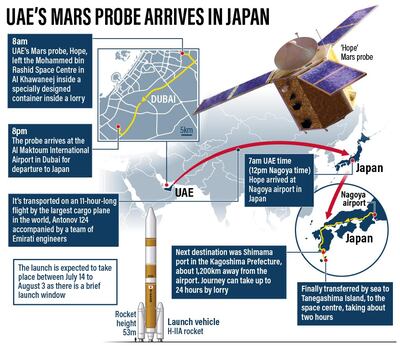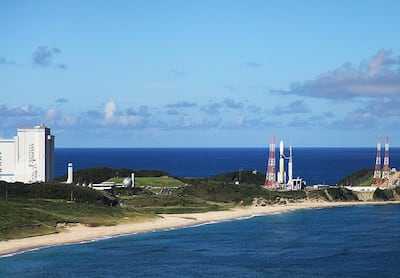It was a journey over land, sea and air that took the UAE’s Mars probe from a Dubai suburb to the far side of the world. But after 83 hours the hand-finished space orbiter arrived on Tanegashima Island – 1,000 kilometres south of the capital Tokyo.
It was no easy feat. The vehicle travelled in a special container to avoid damage and flew on one of the world’s largest cargo planes.
A launch date is yet to be confirmed for the Arab world’s first deep space mission, but it has to be between July 14 and August 3, when Earth and Mars align and make the mission possible. If the window is missed, another opportunity could be 26 months away.
Here we take a look at Hope's journey so far…
12-hour crawl down Dubai’s back roads
The first stage was a 68km drive from Mohammed bin Rashid Space Centre in the suburb of Khawaneej to Dubai World Central airport.
It would normally take a vehicle 45 minutes at most, but the lorry carrying the probe took 12 hours.
At 8am sharp, the probe was loaded into a shipping container designed for use as a mobile cleaning room. Its equipment maintains a specific temperature and humidity, uses nitrogen to disinfect the probe and remove dust particles from the air.
The vehicle travelled at an extremely slow pace to reduce vibration and ensure sensitive parts were not damaged.
By 8pm, the delivery arrived at World Central. But there were 71 hours of the journey still remaining.
A flight on the Soviet workhorse of the skies
The probe was loaded into an Antonov 124 – one of the world's largest cargo planes – for an 11-hour flight to Nagoya, Japan's fourth-largest city. An-124s are not a common sight. The plane was introduced in 1982 by Ukrainian Soviet engineers and only 55 were ever built.
The massive aircraft can carry up to 120 tonnes of oversized cargo – that’s about 21 Toyota Land Cruisers or four helicopters with the rotors folded in.
The Hope probe weighs only 1,500kg, about the size of a small car, but the large box had to fit inside.
These aircraft are operated by Maximus Air, an Abu Dhabi aviation company specialising in cargo shipments.
A small team of Emirati engineers used electronic equipment to monitor turbulence during the flight because severe vibrations could damage the probe.
Hope and the crew arrived at Chubu Centrair International Airport in Nagoya at 7am, UAE time, the next day.
1,200km road trip
After 23 hours of travel, the probe had arrived in Nagoya.
Its next destination was Shimama port in Kagoshima Prefecture, which is about 1,200km away from the airport and can take up to 24 hours to reach if travelling by road.
Because the probe had to be transported at an extremely slow pace while on the road, it is likely the duration was far longer. The probe remained in its container throughout the journey.

Reaching the rocket launch site by sea
From Shimama port, Hope was loaded on to a ship and taken around the south side of the Tanegashima Island to reach Tanegashima Space Centre.
And 83 hours after its first lorry ride in Dubai, the probe at last reached its destination.
It will be attached to the H-IIA rocket when it is ready for launch.
The Tanegashima Space Centre is often called the “most beautiful launch facility in the world” because of its picturesque setting.
Hundreds of people typically travel to the island to watch launches but owing to Covid-19 travel restrictions, only local residents will be able to witness this historic launch.
What happens next?
Emirati engineers were given special permission to fly to Japan, which has been in a nationwide state of emergency and had banned foreigners from visiting.
The team travelling with the probe delivered it to another group of engineers who had arrived in Japan weeks earlier and undergone two weeks of quarantine.
These engineers will stay put in Tanegashima until what is hoped to be a landmark launch.













